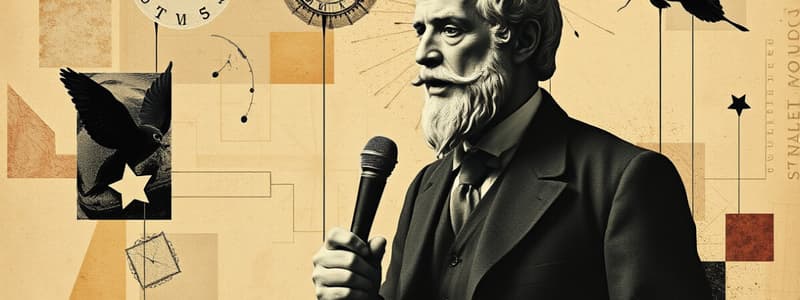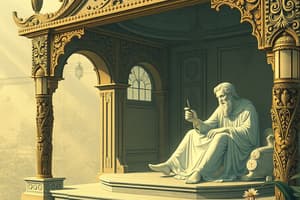Podcast
Questions and Answers
What does the Helical Model of Communication suggest about communication over time?
What does the Helical Model of Communication suggest about communication over time?
- Communication is only effective in childhood.
- Communication processes are separate in different life stages.
- Communication evolves and accumulates experiences over time. (correct)
- Communication remains static throughout a person's life.
In the Transactional Model of Communication, what role do sender and receiver play?
In the Transactional Model of Communication, what role do sender and receiver play?
- Only the sender can provide feedback.
- Both parties simultaneously send and receive messages. (correct)
- The sender is responsible for the message, while the receiver only listens.
- Communication is linear, with distinct roles for sender and receiver.
Which of these components is NOT included in the Transactional Model of Communication?
Which of these components is NOT included in the Transactional Model of Communication?
- Message
- Sender-Receiver
- Channel
- Context (correct)
Why is feedback considered crucial in the communication process?
Why is feedback considered crucial in the communication process?
How can communication effectiveness be impaired according to the content discussed?
How can communication effectiveness be impaired according to the content discussed?
What role does the speaker play in Aristotle's model of communication?
What role does the speaker play in Aristotle's model of communication?
Which component in the Shannon-Weaver Model is responsible for converting the message into signals?
Which component in the Shannon-Weaver Model is responsible for converting the message into signals?
What is emphasized in Schramm's model of communication for effective communication?
What is emphasized in Schramm's model of communication for effective communication?
In Eugene White's communication model, what stage occurs right after 'Thinking'?
In Eugene White's communication model, what stage occurs right after 'Thinking'?
According to the Shannon-Weaver Model, what is referred to as 'noise'?
According to the Shannon-Weaver Model, what is referred to as 'noise'?
What can cause miscommunication in Schramm's model of communication?
What can cause miscommunication in Schramm's model of communication?
What sequence of components is included in Eugene White's model of communication?
What sequence of components is included in Eugene White's model of communication?
Which of the following best defines the 'Receiver' in the Shannon-Weaver Model?
Which of the following best defines the 'Receiver' in the Shannon-Weaver Model?
Flashcards are hidden until you start studying
Study Notes
Aristotle's Model of Communication
- Aristotle is considered a pioneer in rhetoric, focusing on public speaking as the main communication form.
- Key components include:
- Speaker: Delivers the message.
- Message: The content conveyed.
- Audience: Receivers of the message.
- The effectiveness of public speaking relies on the speaker's analysis of the audience to tailor the message for persuasion.
Shannon-Weaver Model of Communication
- Developed by Claude Shannon and Warren Weaver, known as the Telephone Model.
- Main components include:
- Sender: Originates the message.
- Encoder: Converts the message into signals.
- Channel: Medium for message transmission.
- Decoder: Reverts signals back to a message.
- Receiver: End target of the message.
- Noise: Interference that can distort the message.
- Noise can lead to discrepancies between the sent and received messages, affecting clarity.
Schramm Model of Communication
- Wilbur Schramm, known as the Father of Mass Communication, introduced a model emphasizing shared experiences.
- Main components include:
- Source: Sends the message.
- Encoder: Converts thoughts for communication.
- Message: Content being shared.
- Channel: Medium for sending the message.
- Decoder: Receiver's interpretation process.
- Receiver: The recipient of the message.
- Field of Experience: Shared experiences influencing understanding.
- Effective communication occurs when sender and receiver share overlapping fields of experience, while miscommunication arises without this overlap.
Eugene White's Model of Communication
- Proposed a cyclical communication model highlighting its dynamic nature.
- Main components include:
- Thinking: Initial idea formation.
- Symbolizing: Converting ideas into symbols or language.
- Expressing: Delivering the message.
- Transmitting: Sending the message via a channel.
- Receiving: The receipt of the message.
- Decoding: Interpretation of the message.
- Feedbacking: Receiver's response.
- Monitoring: Adjusting based on feedback.
- Communication is a continuous process without a clear start or end, and feedback is essential for closing the communication loop.
Helical Model of Communication
- Developed by Frank Dance in 1967, likening communication to a helix to symbolize continuity and progression.
- The helix shape represents communication as a cumulative process that evolves over time.
- Communication is viewed as a lifelong journey, starting from birth and nurturing development through experiences.
Transactional Model of Communication
- This model highlights the interactive nature of communication where sending and receiving messages occurs simultaneously.
- Components include:
- Sender-Receiver: Interchangeable roles participating in the message exchange.
- Message: Information exchanged between parties.
- Channel: Medium used for sending messages.
- Feedback: Receiver's response that informs the sender.
- Noise: Interference that can disrupt the message.
- Emphasizes that communication is a continuous loop, with feedback essential to the process.
Studying That Suits You
Use AI to generate personalized quizzes and flashcards to suit your learning preferences.




